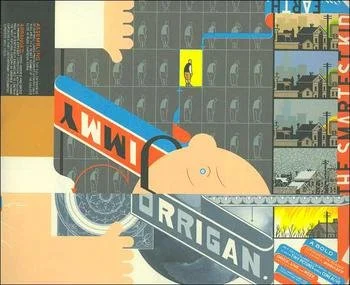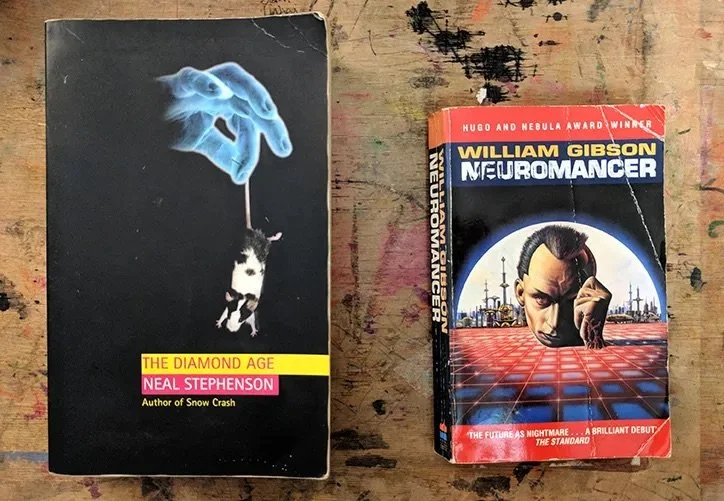As someone whose career involves developing potentials for the future of reading, including books which can be “owned” and “borrowed” through the use of blockchain technology; and a novel set inside Google’s street view, both as part of Editions at Play, we couldn’t pass up the opportunity to find out which books from the past have impacted the brilliant Tea Uglow.
Tea is the creative director at Google’s Creative Lab in Sydney – a role which sees her working with cultural and creative organisations around the world to explore what happens when technology and the arts intersect. Despite forging such a tech-focused career, Tea grew up in a publishing family surrounded by editors, writers and academics and later gained a masters degree in book art at Camberwell College of Arts.
“I used to make mazes in my room made of books,” Tea recalls of her childhood. “While I think we can lose ourselves in a narrative on a Kindle just as easily as in a paperback, I have spent years coming to realise that the physical vessel is as significant as the abstract content,” she explains.
Tea’s Bookshelf is a true variety, including influential reads, personal stories and books with hardly any words. However, ultimately “my happiest moments are on looking up from a book, and waking as if from a dream,” she concludes.
Geoff Ryman: 253 (Harper Collins, originally online only 1996, physically published in 1998)
Based on the surreal premise of a London Underground train with every seat occupied and no-one standing, this hypertext novel massively inspired me as an undergraduate art student. Mainly around the idea of narrative as a collective of multiple strands – an idea we now call multidimensional threading.
As the intro states: “There are seven carriages on a Bakerloo Line train, each with 36 seats. A train in which every passenger has a seat will carry 252 people. With the driver, that makes 253.” 253 people, heading towards disaster. It had added resonance because I lived on that part of the line for many years. It is a book that makes it almost impossible not to see the infinite multiplicity of a story every time you step onto a platform.
Online 253 is about a web of connections, linearly in print, it becomes more stark, dramatic and different. 253 “translates” across media and changes and morphs in translation. You need to read both.
Jonathan Safran Foer: Tree of Codes (Visual Editions, 2010)
I love this book for two reasons. Firstly it is like a moment of magic in the world of publishing. A “they said it couldn’t be done” miracle of print wizardry. To create the book, Foer took Bruno Schulz’s book The Street of Crocodiles and cut out the majority of the words, making it practically (as in, almost literally) impossible to read. But it is a magical object, one that shouldn’t be possible, and has both its own extruded story weaving through it, whilst the erased can only be inferred.
Secondly, it led to me meeting the publishers. I was chatting to a friend in London one day and told her about this incredible book and I think I was idly commenting that it must be American as there was no way an English publisher would have the courage and the chutzpah to pull it off. And she pointed over her shoulder and told me that they sat behind her. Suitably chastised, I humbly begged an audience with Anna and Britt, now Visual Editions, and we have been working together ever since on a number of weird and wonderful publications some of which have come close to Tree of Codes.
William Shakespeare: A Midsummer Night’s Dream
I’m not about to pretend to be a Shakespeare buff. I mean, I like his work and stuff, but this is here because it was my working copy that I carried with me for a year when I was working on an extended version of the play called Dream40 with the Royal Shakespeare Company. At the end everyone signed my book, which made me absurdly happy, despite the project itself being one of the great learning experiences of my career. #dream40 was an experiment in online narrative for the digital creative world from local theatre through to global agencies – it was about what happens when narrative from the centre of power slips off the stage an onto the internet. In fact, in many ways, it was a nice precedent to “Trumpian” politics, except we had a hard and fast rule that kings and fairies could not, and would not tweet.
Chris Ware: The Smartest Kid on Earth (ACME 2000)
There are lots of genre authors I wanted to include wholesale who don’t have anything to declare except their genius (David Mitchell, Robert Harris, Neal Stephenson, Hilary Mantel), but I decided to choose only one that doesn’t have a tech angle to accompany it, and I surprised myself. Jimmy Corrigan is just burnt deep down in me. It’s the book that I used to look up from at the breakfast table and tell myself, “it’s okay, it’s not you.” It made me cry and cry and yet it has hardly any words, just pure, simple, geometric illustration. It’s not a “graphic” graphic novel but it’s a really powerful exploration of the narrative potential of form within strict parameters. So this is my choice for the book that shows what you can do and how far you can go. It’s also a rather sad story about the lonely life of a kid called Jimmy, and his relationship with his estranged father.
William Gibson: Neuromancer (1984) and Neal Stephenson: The Diamond Age (1995)
Okay. So this is cheating. But I can’t pick one over the other. The power of sci-fi on impressionable young minds. These two are the finest examples of first and second-wave cyberpunk. Why does that matter? Well, much like Simone de Beauvoir and Germaine Greer were to feminism, these books were so powerful and so influential within their readership (namely teenage geeks and nerds) that their acolytes (me included) have spent their whole lives dedicated to implementing and bending their vision of a future to the technology as it developed. VR? AI? Cyberspace? You’re welcome. I go to sleep every night hoping that the Harry Potter generation will be as influential in transforming our society – by integrating the digital into a physical-first world – and release us from the digital-first world we inhabit today.




